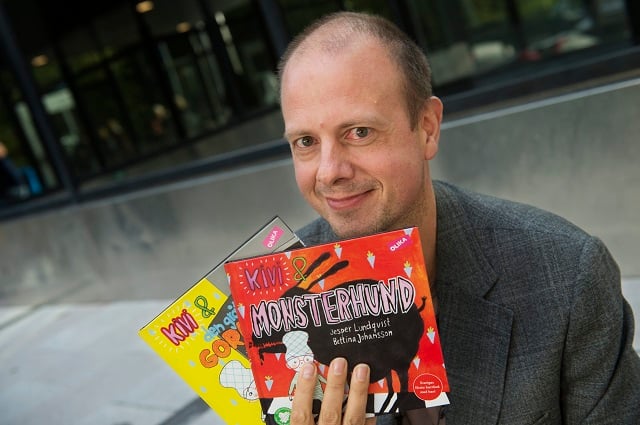Hen: What a three-letter word tells us about Swedish culture

The Swedish language is no stranger to new words, whether they're foreign language imports ("najs") or neologisms created to refer to new or topical concepts ("flygskam"). But one three-letter word has stirred up more controversy than most, and that's "hen".
Hen is Sweden's gender-neutral personal pronoun, which means it replaces hon (she) and/or han (he) when referring to a person of non-binary gender, or in a context where their gender is unknown or irrelevant.
It's used in the same way as hon and han in contexts where the speaker or writer would otherwise need an alternative phrasing such as hon eller han (he or she) or kunden/studenten (the customer/student). An English-language equivalent is single-person "they", and there's an even closer equivalent in Finnish: hän, which has been used in this way since the 16th century and even features in the earliest printed book in the language.
Swedish hen is a much newer creation.
Language professor Karl-Hampus Dahlstedt is the first person to be reported as using the word, as far back as the 1950s; he was familiar with Finnish, so it's likely he took inspiration from the neighbouring country's language (despite few lingustic crossovers between Finnish and Swedish).
Another linguist, Rolf Dunås, wrote a newspaper article proposing the introduction of hen in 1966, and this was the pronoun's first documented appearance in writing.
SWEDISH WORD OF THE DAY: Learn Swedish every day with The Local
For the next generation, its usage was confined to small circles, particularly those which focused on LGBT issues and gender expression. One example was the queer magazine Ful, which used hen from its very first issue in 2008.
The pronoun re-entered mainstream discourse only in 2012, when Olika förlag, a publishing company specialising in promoting "non-traditional" stories, released children's book Kivi och monsterhund (Kivi and monster dog) by Jesper Lundqvist.
The book attracted plenty of media attention thanks to its exclusive use of the pronoun hen to refer to its characters, and helped bring the debate over gender-neutral pronouns to the national level.
Since then, linguistic records show that its use has soared.
Hen was first used in a Swedish court verdict in 2012. The following year hen made its debut in parliament, with the Minister of Gender Equality the first to use it, and the three-letter word entered the Swedish Academy's dictionary in 2015.
Back in 2012 when Kivi och monsterhund was published, hen was only used once in print for every 13,000 uses of han or hon, a ratio which dropped dramatically to once for every 416 the following year. In 2018, hen was used once for every 133 uses of han or hon.
This is actually rather remarkable.

Author Jesper Lundqvist with his norm-challenging book. Photo: Fredrik Sandberg/TT
While the Swedish language, like most living languages, consistently grows and changes, there have been no new pronouns in centuries.
Pronouns are usually considered a closed class, along with determiners (such as ett and en, meaning "a"), conjunctions (such as och, men and eftersom, meaning "and", "but" and "because"), and prepositions (such as i and på, meaning "in" and "on"), in contrast to open word classes such as verbs, nouns and adjectives, which can readily accept new additions.
Hen was able to successfully integrate into the Swedish language thanks to a few points in its favour.
Firstly, pure practicality. Hen is morphologically (structurally) similar to the existing han and hon, so it sounds and looks natural in Swedish texts and writers instinctively know how to use it. And while it's rare for a new pronoun to be created, this is a category of words which is used very frequently, meaning that high repetition boosted hen's chances of survival.
It also serves a clear purpose. When it first appeared in a legal verdict, a court councillor explained that the reason for the decision was that "writing 'he or she' in a text is clunky".
READ ALSO: Six myths about the Swedish language (and why they're untrue)
Although Sweden has two grammatical genders (en words and ett words), these don't correspond to actual gender. For example, en man and en kvinna are both en words, and the words den or det (both meaning "it") refer to objects, but never to people.
So hen fills a gap in the lexicon, which meant it had a better chance of survival; when words disappear from use, it's often because they're competing with synonyms, or because there's overlap between what two words mean, and eventually one of the two becomes used in all contexts while the other falls out of favour.
Cultural developments are also a factor, and arguably the decisive one. As noted, linguists were proposing the use of hen back in the 1950s and 1960s, but it's only over the past ten years that it has reached mainstream consciousness.

Two men kiss at a Gothenburg Pride parade. Photo: Sofia Sabel/imagebank.sweden.se
This coincides with greater discussion about gender norms in Sweden and in society more widely, as well as more and more scientific research which shows gender is not binary. Using hen gives writers a neat alternative to defaulting to the masculine han, and it can also be used to refer to people who do not identify with either traditional gender.
Changes in society are reflected in our language; in 2015, the words icke-binär (non-binary) and cisperson (cisgender person, meaning someone who identifies with the gender they are assigned at birth) were included on the annual "new words list" collated by expert linguists.
Some Swedish preschools have begun to avoid gendered pronouns and making efforts to avoid gendered behaviour. In 2014, the male-dominated builders union Byggnads began using hen in its statutes. And one of Sweden's major teaching unions has guidelines for educational professionals to follow in the usage of hen.
READ ALSO: Swedish church defends gender neutral pronoun for Jesus
The Swedish language has undergone other significant changes in order to reflect those already taking place in society. The obvious example is the "Du reform" of the 1960s, when Sweden overhauled its form of address.
Previously, the pronoun du ("you") was used only to address children, siblings and close friends, or in other extremely informal contexts with no status difference. Elsewhere, there was a rather complex system which involved referring to people in the third person and by their title. This meant saying things like "I hope the manager has a nice weekend" or "Please could the accountant send the documents over?" when speaking to the person in question, and using the titles herr, fru and fröken (Mr, Mrs and Miss) if the person's title or rank was unknown.
In the early 1900s, attempts were made to adopt ni (plural "you") as the formal term of address in parallel to French vous (meaning both plural "you" and formal singular "you") and German Sie (meaning formal "you"). But this never quite took off, and many people instead interpreted ni as a rude implication that the addressee's rank was not important.

Sweden's working culture is typically informal. Photo: Lena Granefelt/imagebank.sweden.se
By the 1950s and 1960s, growing liberalisation provided the appropriate background for the change to du, which began with newspapers such as Dagens Nyheter adopting the term in their style guides, and was spurred along by high-profile figures using the term, not least Prime Minister Olof Palme who, after his appointment in 1969, asked reporters to address him as du.
These days, the lack of formality in the language and especially the use of first names and du even with managers is something that strikes many newcomers to Sweden. It reflects – or perhaps even encourages – typically informal working cultures.
READ ALSO: Children at Sweden's gender-neutral preschools more likely to play with both boys and girls
Language is an evolving organism, and it's defined by how people use it rather than any rules imposed from above. So it makes sense that in order for a language change to take root, it needs to reflect its society.
A study from researchers at Lund University analysed Swedes' feelings about hen. Although the majority of people surveyed said they never used the pronoun, the survey showed that Swedes who live in big cities, were aged under 26, and had a university education, were most positive towards hen and most likely to use it often.
Hen does have its critics, and these are on average more likely to be older people who live in the country and have more conservative political views, according to the same study.
These critics usually see it as a loaded and political term, and even the Swedish Language Council in its usage recommendations notes that its usage could "draw attention away from the text". Because of this potential risk, it suggests that writers "determine whether the word is appropriate or not in the context of the writer, the situation and the recipients", although it does state that hen should always be used to refer to someone who prefers it to hon or han.
Whether hen becomes truly mainstream remains to be seen, but it is a clear example of how language can change in order to keep up with a changing world.
Comments
See Also
It's used in the same way as hon and han in contexts where the speaker or writer would otherwise need an alternative phrasing such as hon eller han (he or she) or kunden/studenten (the customer/student). An English-language equivalent is single-person "they", and there's an even closer equivalent in Finnish: hän, which has been used in this way since the 16th century and even features in the earliest printed book in the language.
Swedish hen is a much newer creation.
Language professor Karl-Hampus Dahlstedt is the first person to be reported as using the word, as far back as the 1950s; he was familiar with Finnish, so it's likely he took inspiration from the neighbouring country's language (despite few lingustic crossovers between Finnish and Swedish).
Another linguist, Rolf Dunås, wrote a newspaper article proposing the introduction of hen in 1966, and this was the pronoun's first documented appearance in writing.
SWEDISH WORD OF THE DAY: Learn Swedish every day with The Local
For the next generation, its usage was confined to small circles, particularly those which focused on LGBT issues and gender expression. One example was the queer magazine Ful, which used hen from its very first issue in 2008.
The pronoun re-entered mainstream discourse only in 2012, when Olika förlag, a publishing company specialising in promoting "non-traditional" stories, released children's book Kivi och monsterhund (Kivi and monster dog) by Jesper Lundqvist.
The book attracted plenty of media attention thanks to its exclusive use of the pronoun hen to refer to its characters, and helped bring the debate over gender-neutral pronouns to the national level.
Since then, linguistic records show that its use has soared.
Hen was first used in a Swedish court verdict in 2012. The following year hen made its debut in parliament, with the Minister of Gender Equality the first to use it, and the three-letter word entered the Swedish Academy's dictionary in 2015.
Back in 2012 when Kivi och monsterhund was published, hen was only used once in print for every 13,000 uses of han or hon, a ratio which dropped dramatically to once for every 416 the following year. In 2018, hen was used once for every 133 uses of han or hon.
This is actually rather remarkable.

Author Jesper Lundqvist with his norm-challenging book. Photo: Fredrik Sandberg/TT
While the Swedish language, like most living languages, consistently grows and changes, there have been no new pronouns in centuries.
Pronouns are usually considered a closed class, along with determiners (such as ett and en, meaning "a"), conjunctions (such as och, men and eftersom, meaning "and", "but" and "because"), and prepositions (such as i and på, meaning "in" and "on"), in contrast to open word classes such as verbs, nouns and adjectives, which can readily accept new additions.
Hen was able to successfully integrate into the Swedish language thanks to a few points in its favour.
Firstly, pure practicality. Hen is morphologically (structurally) similar to the existing han and hon, so it sounds and looks natural in Swedish texts and writers instinctively know how to use it. And while it's rare for a new pronoun to be created, this is a category of words which is used very frequently, meaning that high repetition boosted hen's chances of survival.
It also serves a clear purpose. When it first appeared in a legal verdict, a court councillor explained that the reason for the decision was that "writing 'he or she' in a text is clunky".
READ ALSO: Six myths about the Swedish language (and why they're untrue)
Although Sweden has two grammatical genders (en words and ett words), these don't correspond to actual gender. For example, en man and en kvinna are both en words, and the words den or det (both meaning "it") refer to objects, but never to people.
So hen fills a gap in the lexicon, which meant it had a better chance of survival; when words disappear from use, it's often because they're competing with synonyms, or because there's overlap between what two words mean, and eventually one of the two becomes used in all contexts while the other falls out of favour.
Cultural developments are also a factor, and arguably the decisive one. As noted, linguists were proposing the use of hen back in the 1950s and 1960s, but it's only over the past ten years that it has reached mainstream consciousness.

Two men kiss at a Gothenburg Pride parade. Photo: Sofia Sabel/imagebank.sweden.se
This coincides with greater discussion about gender norms in Sweden and in society more widely, as well as more and more scientific research which shows gender is not binary. Using hen gives writers a neat alternative to defaulting to the masculine han, and it can also be used to refer to people who do not identify with either traditional gender.
Changes in society are reflected in our language; in 2015, the words icke-binär (non-binary) and cisperson (cisgender person, meaning someone who identifies with the gender they are assigned at birth) were included on the annual "new words list" collated by expert linguists.
Some Swedish preschools have begun to avoid gendered pronouns and making efforts to avoid gendered behaviour. In 2014, the male-dominated builders union Byggnads began using hen in its statutes. And one of Sweden's major teaching unions has guidelines for educational professionals to follow in the usage of hen.
READ ALSO: Swedish church defends gender neutral pronoun for Jesus
The Swedish language has undergone other significant changes in order to reflect those already taking place in society. The obvious example is the "Du reform" of the 1960s, when Sweden overhauled its form of address.
Previously, the pronoun du ("you") was used only to address children, siblings and close friends, or in other extremely informal contexts with no status difference. Elsewhere, there was a rather complex system which involved referring to people in the third person and by their title. This meant saying things like "I hope the manager has a nice weekend" or "Please could the accountant send the documents over?" when speaking to the person in question, and using the titles herr, fru and fröken (Mr, Mrs and Miss) if the person's title or rank was unknown.
In the early 1900s, attempts were made to adopt ni (plural "you") as the formal term of address in parallel to French vous (meaning both plural "you" and formal singular "you") and German Sie (meaning formal "you"). But this never quite took off, and many people instead interpreted ni as a rude implication that the addressee's rank was not important.

Sweden's working culture is typically informal. Photo: Lena Granefelt/imagebank.sweden.se
By the 1950s and 1960s, growing liberalisation provided the appropriate background for the change to du, which began with newspapers such as Dagens Nyheter adopting the term in their style guides, and was spurred along by high-profile figures using the term, not least Prime Minister Olof Palme who, after his appointment in 1969, asked reporters to address him as du.
These days, the lack of formality in the language and especially the use of first names and du even with managers is something that strikes many newcomers to Sweden. It reflects – or perhaps even encourages – typically informal working cultures.
READ ALSO: Children at Sweden's gender-neutral preschools more likely to play with both boys and girls
Language is an evolving organism, and it's defined by how people use it rather than any rules imposed from above. So it makes sense that in order for a language change to take root, it needs to reflect its society.
A study from researchers at Lund University analysed Swedes' feelings about hen. Although the majority of people surveyed said they never used the pronoun, the survey showed that Swedes who live in big cities, were aged under 26, and had a university education, were most positive towards hen and most likely to use it often.
Hen does have its critics, and these are on average more likely to be older people who live in the country and have more conservative political views, according to the same study.
These critics usually see it as a loaded and political term, and even the Swedish Language Council in its usage recommendations notes that its usage could "draw attention away from the text". Because of this potential risk, it suggests that writers "determine whether the word is appropriate or not in the context of the writer, the situation and the recipients", although it does state that hen should always be used to refer to someone who prefers it to hon or han.
Whether hen becomes truly mainstream remains to be seen, but it is a clear example of how language can change in order to keep up with a changing world.
Join the conversation in our comments section below. Share your own views and experience and if you have a question or suggestion for our journalists then email us at [email protected].
Please keep comments civil, constructive and on topic – and make sure to read our terms of use before getting involved.
Please log in here to leave a comment.